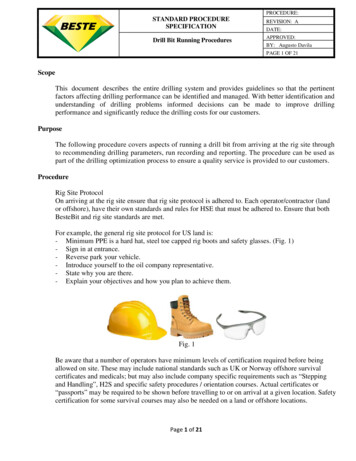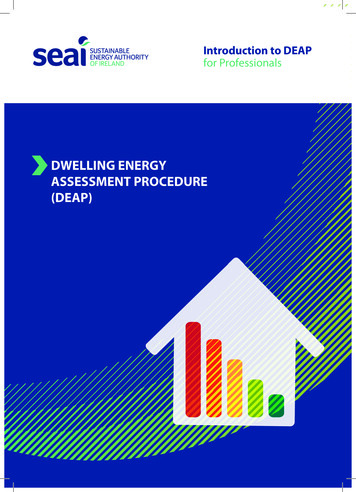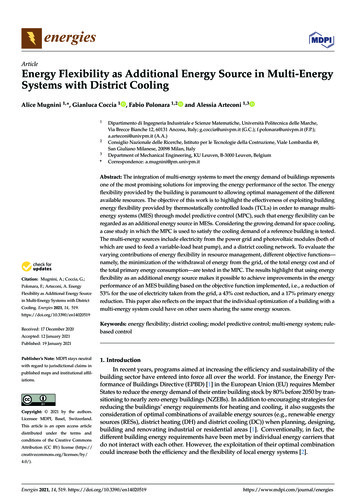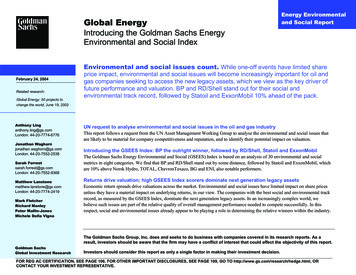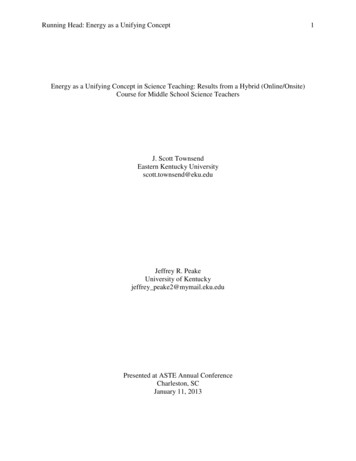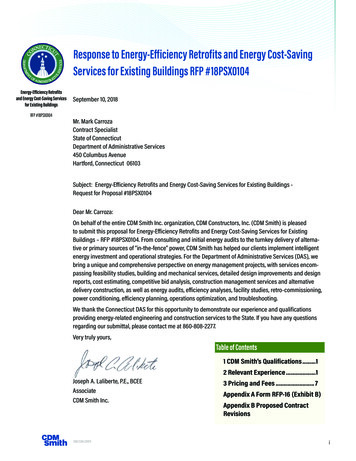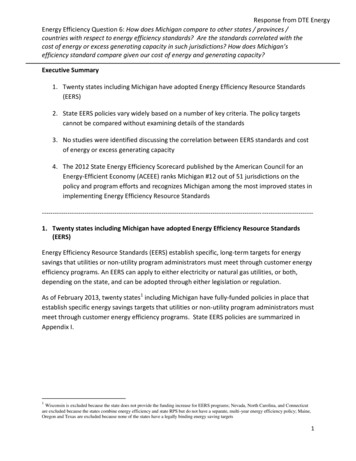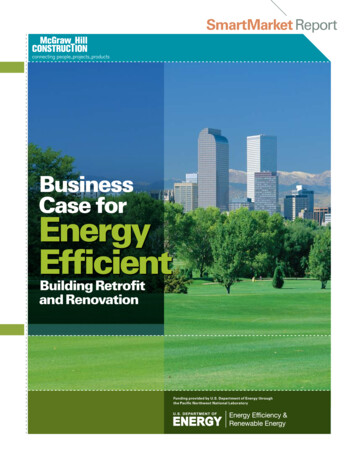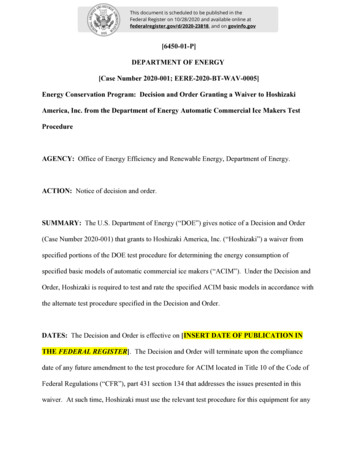
Transcription
This document is scheduled to be published in theFederal Register on 10/28/2020 and available online atfederalregister.gov/d/2020-23818, and on govinfo.gov[6450-01-P]DEPARTMENT OF ENERGY[Case Number 2020-001; EERE-2020-BT-WAV-0005]Energy Conservation Program: Decision and Order Granting a Waiver to HoshizakiAmerica, Inc. from the Department of Energy Automatic Commercial Ice Makers TestProcedureAGENCY: Office of Energy Efficiency and Renewable Energy, Department of Energy.ACTION: Notice of decision and order.SUMMARY: The U.S. Department of Energy (“DOE”) gives notice of a Decision and Order(Case Number 2020-001) that grants to Hoshizaki America, Inc. (“Hoshizaki”) a waiver fromspecified portions of the DOE test procedure for determining the energy consumption ofspecified basic models of automatic commercial ice makers (“ACIM”). Under the Decision andOrder, Hoshizaki is required to test and rate the specified ACIM basic models in accordance withthe alternate test procedure specified in the Decision and Order.DATES: The Decision and Order is effective on [INSERT DATE OF PUBLICATION INTHE FEDERAL REGISTER]. The Decision and Order will terminate upon the compliancedate of any future amendment to the test procedure for ACIM located in Title 10 of the Code ofFederal Regulations (“CFR”), part 431 section 134 that addresses the issues presented in thiswaiver. At such time, Hoshizaki must use the relevant test procedure for this equipment for any
testing to demonstrate compliance with the applicable standards, and any other representations ofenergy use.FOR FURTHER INFORMATION CONTACT:Ms. Lucy deButts, U.S. Department of Energy, Office of Energy Efficiency and RenewableEnergy, Building Technologies Office, EE-5B, 1000 Independence Avenue, SW., Washington,DC, 20585-0121. E-mail: AS Waiver Requests@ee.doe.gov.Ms. Sarah Butler, U.S. Department of Energy, Office of the General Counsel, Mail Stop GC-33,Forrestal Building, 1000 Independence Avenue, SW., Washington, DC 20585-0103. Telephone:(202) 586-1777. E-mail: Sarah.Butler@hq.doe.gov.SUPPLEMENTARY INFORMATION: In accordance with Title 10 of the Code of FederalRegulations (10 CFR 431.401(f)(2)), DOE gives notice of the issuance of its Decision and Orderas set forth below. The Decision and Order grants Hoshizaki a waiver from the applicable testprocedure at 10 CFR 431.134 for specified basic models of ACIM and provides that Hoshizakimust test and rate such equipment using the alternate test procedure specified in the Decision andOrder. Hoshizaki’s representations concerning the energy consumption of the specified basicmodels must be based on testing according to the provisions and restrictions in the alternate testprocedure set forth in the Decision and Order, and the representations must fairly disclose thetest results. Distributors, retailers, and private labelers are held to the same requirements whenmaking representations regarding the energy consumption of this equipment. (42 U.S.C.6314(d))
Consistent with 10 CFR 431.401(j), not later than [INSERT DATE 60 DAYS AFTERDATE OF PUBLICATION IN THE FEDERAL REGISTER], any manufacturer currentlydistributing in commerce in the United States equipment employing a technology orcharacteristic that results in the same need for a waiver from the applicable test procedure mustsubmit a petition for waiver. Manufacturers not currently distributing such equipment incommerce in the United States must petition for and be granted a waiver prior to the distributionin commerce of that equipment in the United States. 10 CFR 431.401(j). Manufacturers mayalso submit a request for interim waiver pursuant to the requirements of 10 CFR 431.401.Signing AuthorityThis document of the Department of Energy was signed on October 22, 2020, by Alexander N.Fitzsimmons, Deputy Assistant Secretary for Energy Efficiency, Energy Efficiency andRenewable Energy, pursuant to delegated authority from the Secretary of Energy. Thatdocument with the original signature and date is maintained by DOE. For administrativepurposes only, and in compliance with requirements of the Office of the Federal Register, theundersigned DOE Federal Register Liaison Officer has been authorized to sign and submit thedocument in electronic format for publication, as an official document of the Department of
Energy. This administrative process in no way alters the legal effect of this document uponpublication in the Federal Register.Signed in Washington, DC, on October 23, 2020Treena V. Garrett,Federal Register Liaison Officer,U.S. Department of Energy.
Case # 2020-001Decision and OrderI.Background and AuthorityThe Energy Policy and Conservation Act, as amended (“EPCA”),1 authorizes the U.S.Department of Energy (“DOE”) to regulate the energy efficiency of a number of consumerproducts and certain industrial equipment. (42 U.S.C. 6291–6317) Title III, Part C2 of EPCAestablished the Energy Conservation Program for Certain Industrial Equipment, which sets fortha variety of provisions designed to improve energy efficiency for certain types of industrialequipment. This equipment includes automatic commercial ice makers (“ACIM”), the focus ofthis document. (42 U.S.C. 6311(1)(F))The energy conservation program under EPCA consists essentially of four parts: (1)testing, (2) labeling, (3) Federal energy conservation standards, and (4) certification andenforcement procedures. Relevant provisions of EPCA include definitions (42 U.S.C. 6311), testprocedures (42 U.S.C. 6314), labeling provisions (42 U.S.C. 6315), energy conservationstandards (42 U.S.C. 6313), and the authority to require information and reports frommanufacturers (42 U.S.C. 6316).The Federal testing requirements consist of test procedures that manufacturers of coveredequipment must use as the basis for: (1) certifying to DOE that their equipment complies withthe applicable energy conservation standards adopted pursuant to EPCA (42 U.S.C. 6316(a); 42U.S.C. 6295(s)), and (2) making representations about the efficiency of that equipment (42All references to EPCA in this document refer to the statute as amended through America’s Water InfrastructureAct of 2018, Public Law 115-270 (Oct. 23, 2018).2 For editorial reasons, upon codification in the U.S. Code, Part C was redesignated as Part A-1.1
U.S.C. 6314(d)). Similarly, DOE must use these test procedures to determine whether theequipment complies with relevant standards promulgated under EPCA. (42 U.S.C. 6316(a); 42U.S.C. 6295(s))Under 42 U.S.C. 6314, EPCA sets forth the criteria and procedures DOE is required tofollow when prescribing or amending test procedures for covered equipment. EPCA requiresthat any test procedures prescribed or amended under this section must be reasonably designed toproduce test results which reflect energy efficiency, energy use or estimated annual operatingcost of covered equipment during a representative average use cycle and requires that testprocedures not be unduly burdensome to conduct. (42 U.S.C. 6314(a)(2)) The test procedure forACIM is contained at 10 CFR 431.134.Any interested person may submit a petition for waiver from DOE’s test procedurerequirements. 10 CFR 431.401(a)(1). DOE will grant a waiver from the test procedurerequirements if DOE determines either that the basic model for which the waiver was requestedcontains a design characteristic that prevents testing of the basic model according to theprescribed test procedures, or that the prescribed test procedures evaluate the basic model in amanner so unrepresentative of its true energy consumption characteristics as to providematerially inaccurate comparative data. 10 CFR 431.401(f)(2). DOE may grant the waiversubject to conditions, including adherence to alternate test procedures. Id.II.Hoshizaki’s Petition for Waiver: Assertions and DeterminationsBy letter dated January 28, 2020, Hoshizaki filed a petition for waiver and a petition forinterim waiver from the DOE test procedure applicable to ACIM set forth in 10 CFR 431.134.Hoshizaki additionally responded by email to two DOE requests for technical information on
February 13, 2020 and March 19, 2020.3 Hoshizaki stated that the issue with the DOE ACIMtest procedure is the requirement for the ice bin to be one-half full of ice prior to the test.Specifically, Hoshizaki cited the test condition in section 6.5 of American Society of Heating,Refrigerating and Air-Conditioning Engineers (“ASHRAE”) Standard 29-2009, Method ofTesting Automatic Ice Makers (“ASHRAE Standard 29-2009”), which is incorporated byreference in the DOE ACIM test procedure. See 10 CFR 431.133 and 10 CFR 431.134(b).Section 6.5 of ASHRAE Standard 29-2009 requires in relevant part that “Bins shall be usedwhen testing and shall be filled one-half full with ice.” Additionally, the DOE ACIM testprocedure requires, through reference to section 7.2.1 of ASHRAE Standard 29-2009, that iceproduced during the collection period be “intercepted” from the half-full bin for the purpose ofdetermining the capacity of the unit under test.In the models for which Hoshizaki requested a waiver, DCM-270BAH and DCM270BAH-OS, the ice bin is situated above the evaporator and ice is pushed up through theevaporator directly into the bottom of the bin. Therefore, Hoshizaki claimed that an ice bin onehalf full of ice prior to the test makes it impossible to accurately test because ice produced duringthe test cannot be readily distinguished from the ice placed in the bin prior to the test (ascompared to units in which the ice is dropped into a bin below the production area – allowing for“intercepting” the ice produced during the test). Hoshizaki requested an alternate test procedurein which testing is started with an empty internal bin and ice is harvested through continuousoperation of the unit’s dispenser as opposed to collection in the internal bin.3See documents in the Docket No. EERE-2020-BT-WAV-0005 available on http://www.regulations.gov.
On July 23, 2020, DOE published a notice that announced its receipt of the petition forwaiver and granted Hoshizaki an interim waiver. 85 FR 44529 (“Notice of Petition forWaiver”). In the Notice of Petition for Waiver, DOE reviewed Hoshizaki’s application for aninterim waiver, the alternate test procedure requested by Hoshizaki, specification and parts sheetsfor the specified basic models, and additional technical correspondence. Based on this review,DOE granted Hoshizaki an interim waiver for its Hoshizaki branded DCM-270BAH and DCM270BAH-OS ACIM basic models. The alternate test procedure granted to Hoshizaki in theinterim waiver provides additional clarification to the alternate test procedure requested byHoshizaki, but does not change the test setup or conduct requested by Hoshizaki.By letter dated July 28, 2020, Hoshizaki requested that the interim waiver be extended toinclude two additional basic models of ACIM, Hoshizaki branded DCM-271BAH and DCM271BAH-OS, and that these two additional basic models be considered under its petition forwaiver. 4 Hoshizaki stated that the two additional basic models employ the same technology asthe basic models set forth in the January 28, 2020 petition. DOE has reviewed Hoshizaki’swaiver extension request and determined that the basic models identified in Hoshizaki’s requestincorporate the same design characteristics as those basic models set forth in the January 28,2020 petition such that the test procedure evaluates those basic models in a manner that isunrepresentative of their energy use. In accordance with 10 CFR 431.401(g), DOE is includingthese additional basic models in the scope of the waiver granted to Hoshizaki in the Decision andOrder.4See Docket No. EERE-2020-BT-WAV-0005 available on http://www.regulations.gov.
In the Notice of Petition for Waiver, DOE also solicited comments from interested partieson all aspects of the petition and the specified alternate test procedure. Id. DOE received onecomment in response to the Notice of Petition of Waiver from the Pacific Gas and ElectricCompany, San Diego Gas and Electric, and Southern California Edison, collectively referred toherein as the California Investor-Owned Utilities (“CA IOUs”).5 The CA IOUs agreed with theinterim waiver approach of testing the specified basic models by bypassing the internal storagebin and collecting ice directly from the dispensing apparatus, which is held open via a bracket,because such testing would not increase power consumption of the unit and would not beanticipated to directly impact capacity, energy consumption, water consumption, and/or icedensity. However, the CA IOUs suggested modifying the interim waiver test procedure byrequiring that Hoshizaki supply the test laboratory with an ice storage bin and have the bin beone-half filled with ice for testing to more closely match the test requirements for other ACIM.The CA IOUs further recommended that the supplemental ice bin be equipped with its specifiedlid or be covered as much as possible with an insulating material to simulate the enclosed state ofthe internal bin in the unit under test. The CA IOUs noted that other ACIM, when tested to theDOE ACIM test procedure, dispense ice into the unit’s ice bin, which is one-half filled with ice,to simulate field conditions for the internal rate of ice melt and to stabilize the temperature of therecently produced ice. The CA IOUs also recommended that the Decision and Order waiver beretired once this scenario is incorporated into an updated industry standard and is referenced bythe DOE ACIM test procedure. (CA IOUs, No. 6 at pp. 1-2)5The CA IOUs comment can be accessed at: 0005-0006
In response to the comment by the CA IOUs, DOE agrees that the suggested approach ofcollecting the dispensed ice in an external ice bin that is one-half full of ice better represents theice produced in field conditions and maintains consistency with testing other ACIM according tothe DOE test procedure. The ice generated during normal operation of the specified basicmodels would typically be stored for some period of time in the models’ internal storage bins andwould melt at a slower rate compared to ice collected and held in an empty container exposed tothe ambient test conditions for the duration of the 14.4-minute ice collection period specified insection 7.2 of ASHRAE Standard 29-2009. For continuous ACIM, the melt rate of ice collectedduring testing affects the measured ice hardness factor, which is the latent heat capacity of theharvested ice. 10 CFR 431.132. This measurement accounts for the presence of any liquid waterin ice produced by continuous ACIM and is used to normalize the measured energy consumptionto a standardized ice quality. For the basic models at issue in the Hoshizaki petition, collectingice samples within ice storage bins half full of ice rather than in empty collection containerswould allow for determining ice hardness factors that are more representative of ice producedduring typical operation. However, because the specific basic models do not have an associatedexternal ice storage bin and because manufacturers are not always involved in performancetesting of their basic models, requiring Hoshizaki to provide a specific ice bin for testing wouldbe burdensome and inappropriate for certain types of testing. Therefore, DOE is not specifying aspecific external ice storage bin for testing, but is requiring that the specified basic models betested with the minimum length of conduit that can be used connecting the dispenser to anexternal ice bin, which must be filled one-half full with ice. This requirement is consistent withthe ice bin requirements specified in section 6.5 of ASHRAE Standard 29-2009.
DOE also agrees with the CA IOUs’ recommendation regarding the waiver no longerbeing effective when DOE ACIM test procedure is updated to address this test issue. DOE’sregulations require that when the test procedure is amended to address the issues presented in awaiver, the waiver will automatically terminate on the date on which use of that test procedure isrequired to demonstrate compliance. 10 CFR 431.401(h)(2).For the reasons explained here and in the Notice of Petition for Waiver, absent a waiverthe basic models identified by Hoshizaki in its original petition and scope extension requestcannot be tested and rated for energy consumption on a basis representative of their true energyconsumption characteristics. DOE has reviewed the recommended procedure suggested byHoshizaki and concludes that a modified version of the recommended alternate test procedurewill allow for the accurate measurement of the energy use of the equipment, while alleviating thetesting problems associated with Hoshizaki’s specified basic models. DOE amended thealternate test procedure specified in the interim waiver granted to Hoshizaki based on thecomment received in the Notice of Petition for Waiver, as discussed in this section.Thus, DOE is requiring that Hoshizaki test and rate its specified ACIM basic modelsaccording to the alternate test procedure specified in this Decision and Order.This Decision and Order is applicable only to the basic models listed and does not extendto any other basic models. DOE evaluates and grants waivers for only those basic modelsspecifically set out in the petition, not future models that may be manufactured by the petitioner.Hoshizaki may request that DOE extend the scope of this waiver to include additional basicmodels that employ the same technology as those listed in this waiver. 10 CFR 431.401(g).Hoshizaki may also submit another petition for waiver from the test procedure for additional
basic models that employ a different technology and meet the criteria for test procedure waivers.10 CFR 431.401(a)(1).DOE notes that it may modify or rescind the waiver at any time upon DOE’sdetermination that the factual basis underlying the petition for waiver is incorrect, or upon adetermination that the results from the alternate test procedure are unrepresentative of the basicmodels’ true energy consumption characteristics. 10 CFR 431.401(k)(1). Likewise, Hoshizakimay request that DOE rescind or modify the waiver if the company discovers an error in theinformation provided to DOE as part of its petition, determines that the waiver is no longerneeded, or for other appropriate reasons. 10 CFR 431.401(k)(2).As set forth above, the test procedure specified in this Decision and Order is not the sameas the test procedure offered by Hoshizaki. If Hoshizaki believes that the alternate test method itsuggested provides representative results and is less burdensome than the test method requiredby this Decision and Order, Hoshizaki may submit a request for modification under 10 CFR431.401(k)(2) that addresses the concerns that DOE has specified with that procedure.Hoshizaki may also submit another less burdensome alternative test procedure not expresslyconsidered in this notice under the same provision.III.OrderAfter careful consideration of all the material that was submitted by Hoshizaki, thevarious public-facing materials (e.g., product specification sheets) for the models identified inthe petition, and the comment received, in this matter, it is ORDERED that:
(1) Hoshizaki must, as of the date of publication of this Order in the Federal Register, test andrate the following ACIM basic models with the alternate test procedure as set forth in paragraph(2):BrandBasic izakiDCM-271BAHHoshizakiDCM-271 BAH-OS(2) The alternate test procedure for the Hoshizaki basic models listed in paragraph (1) of thisOrder is the test procedure for ACIM prescribed by DOE at 10 CFR 431.134, with themodifications provided below. All other requirements of 10 CFR 431.134 and DOE’s otherrelevant regulations remain applicable.Prior to the start of the test, remove the front panel of the unit under test and insert abracket to hold the shutter
In the models for which Hoshizaki requested a waiver, DCM-270BAH and DCM-270BAH-OS, the ice bin is situated above the evaporator and ice is pushed up through the evaporator directly into the bottom of t
